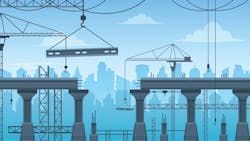By Gavin Jenkins, Senior Managing Editor
Last year, there was an abundance of optimism in the roads and bridges construction industry, and that hopefulness seems to have been validated.
As we begin 2024, the state of the industry is good. In fact, one might be tempted to say the industry is thriving. This fall, the bipartisan Infrastructure Investment and Jobs Act (IIJA) celebrated its second anniversary, and that influx of money— a $1.2 trillion infrastructure package that will deliver $550 billion in federal investments over five years —is funding road and bridge projects across the country.
There are a few serious caveats that are preventing everyone in the industry from celebrating, specifically regarding labor, prices, policy, and law implementation. However, last year at this time, the IIJA was still in its infancy, and money was moving slowly. Some may say it’s still moving slowly, but the industry leapt forward in 2023, and with billions of dollars set to be dispersed, 2024 looks to be an even better year.
This past summer, Roads & Bridges conducted its annual multi-part state of the industry survey. Respondents represented highway/heavy construction (55%), both building and highway construction (19%), general building construction (11%), technology development (6%), and material production (9%).
An impressive 85% of respondents said that 2023 was an excellent, very good, or good year for their company. Roughly the same percentage of respondents expect 2024 to be excellent, very good, or good.
“We are very much at the dawn of an infrastructure decade,” U.S. Transportation Secretary Pete Buttigieg said to the Indianapolis Star in August.
Many of our readers are prepared to take advantage of this era. When asked about the overall health of their businesses, most respondents answered good (43%) or very good (33%). Another 16% described the state of their firms as average.
Not surprisingly, when asked about the economic conditions in their state, specifically when it comes to road and bridge projects, 75% of respondents described it as good or fair. For that question, 12% said it was poor. And of the respondents who said fair or poor, 56% said they expect to see the industry improve in 2024 and 2025.
As positive as this news is, the survey produced some sobering results. Roughly 73% of respondents rated the availability of qualified workers for job openings as weak or very weak.
The IIJA promises to repair crumbling roads and bridges, as well as build new infrastructure. But what good will the law’s billions of dollars of investment do if there aren’t enough people qualified to do the work?
In early 2023, there were 129,000 construction job openings, according to a Labor Department report. While many aspects of American society and government have rebounded from the pandemic, it seems that the labor shortage has not. Julia Pollak, an economist at ZipRecruiter, told NPR earlier this year that the number of people actively applying to construction jobs fell 40% between 2019 and 2020 and has been flat ever since.
Combine that with the quality of workers, and the industry’s pipeline problem becomes glaring. The IIJA invests in community, state, and federal projects, but it fails to set aside money for training workers. And of the 414 funding grants within the bipartisan infrastructure law, just 57 are eligible to be used to fund work-force related efforts, according to the National Governors’ Association.
Ken Simonson, chief economist at Associated General Contractors of America, told NPR that the IIJA pressures already stretched unions and construction firms to find workers in a tight hiring pool.
"What this legislation does is put the emphasis on getting firms to support and hire people coming through apprenticeship programs," Simonson said to NPR. "But it's not directly helping to create those programs."
When asked what could improve the labor shortage the most, 50% of our respondents said upgrading high school and vo-tech school programs, while 32% said apprenticeship programs.
The IIJA’s failure to help the industry rebuild its pipeline of qualified workers lead us to the most interesting aspect of the survey.
Though most respondents expressed optimism with the state of the industry, which is directly related to the IIJA and its $550 billion in federal investments, 59% are disappointed or very upset with how the Biden administration is implementing the law.
A slight contradiction to this: Approximately 36% of respondents said their understanding of the IIJA could be described as weak or very weak. An additional 41% described their knowledge of the law as average.
How can people be disappointed in a law they don’t understand? It’s simple: the Buy America provisions are complicated and challenging to navigate, and the grant process is frustrating.
As secretary, Buttigieg is responsible for the IIJA’s implementation. His favorability was not polled in the survey because the answer is obvious: it’s low. The former mayor, who had never worked at a state department of transportation prior to joining the Biden administration, had a rough 2023 to say the least. It started in the final days of 2022, when Southwest cancelled 16,000 flights because of an outdated software system, and it got worse from there, with multiple train derailments, including one in East Palestine, Ohio, which received national attention. Like the implementation of the IIJA, Buttigieg’s handling of these situations have been called into question.
Perhaps Buttigieg’s favorability would improve if America’s bridges progressed faster.
One out of three U.S. bridges still needs replaced or repaired, according to the American Road and Transportation Association (ARTBA). That’s more than 222,000 bridges, including 76,600 that need replaced.
In 2023, the number of bridges in poor condition declined by 560 compared to 2022. Most of our respondents couldn’t tell; 54% said they thought it stayed the same. Maybe that’s because, at this pace, it could take nearly 75 years to repair them all, according to ARTBA.
Our survey broke down roads into three categories — urban, rural, and interstate — and according to respondents, each system is doing roughly the same. Urban roads were fair (43.5%) or good (30%). However, 62% described urban roads as in decline.
Rural roads seem to be on par, with 54% in fair condition and 30% in good condition. But 60% think they are declining, as well. Interstate roads seem to be doing the best, with 45% describing them as good and 35% as fair. Yet, 53% also described them as declining.
Neither roads nor bridges can be built or repaired without materials, and that brings us to the final concern our respondents expressed.
The American economy is not in a recession, thanks in part two quarters of growth during the first half of 2023. The Inflation Reduction Act seems to have worked, as well. Inflation peaked at 9.1% in 2022. Currently, it sits at 3.24%, according to the U.S. Bureau of Labor Statistics. The Federal Reserve’s target is 2%.
This means that inflation is still too high, and prices aren’t going down soon. That will hit the roads and bridges construction industry during the first quarter of 2024, and our respondents know this: 74% said they expect material prices to rise this year.
Between asphalt, cement, aggregate, steel, rebar, and pavement markings, respondents expect prices for asphalt (86%) to go up the most, with cement and steel following.
If materials cost more, then project bids will go up, too, and 67% of respondents agreed.
The roads and bridges construction industry is competitive, and with the IIJA finally hitting its stride, the overall state of the industry is good. But these concerns are valid and need to be addressed because people’s lives are at stake. There’s a safety factor, of course, but there also is this fact: when asked if they have enough funds to adequately maintain their business in 2024, 36% said no and 25% responded “I don’t know.”
That much uncertainty is unacceptable in the infrastructure decade. R&B



